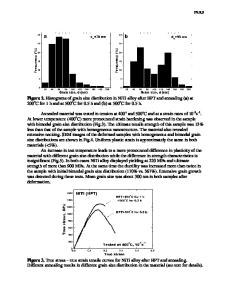Effect of Aluminum and Grain Size on the Fracture Behavior of Twinning-Induced Plasticity Steels
- PDF / 2,093,425 Bytes
- 7 Pages / 593.972 x 792 pts Page_size
- 35 Downloads / 372 Views
Effect of Aluminum and Grain Size on the Fracture Behavior of Twinning-Induced Plasticity Steels Z.C. LUO and M.X. HUANG The present study investigates the effect of Al and grain size on the notch sensitivity and fracture toughness of twinning-induced plasticity (TWIP) steels. It is evident that the notch sensitivity and fracture toughness of TWIP steels can be improved by the addition of Al and grain refinement. Furthermore, the relatively low fracture toughness and high-notched sensitivity of coarse-grained TWIP steels can be explained by a quasi-cleavage fracture mechanism. https://doi.org/10.1007/s11663-018-1346-0 Ó The Minerals, Metals & Materials Society and ASM International 2018
I.
INTRODUCTION
HIGH-MANGANESE twinning-induced plasticity (TWIP) steels have attracted intensive research interests in recent years owing to their exceptional combination of strength and ductility, which are mutually exclusive for other materials.[1–8] Such excellent properties make them possible for use in large-scale applications in various industrial fields. However, after forming, the product contains high residual stress, which may contribute to the initiation and propagation of cracks by the help of hydrogen, i.e., the hydrogen-induced delayed fracture (HDF).[9–12] Many research works have investigated the HDF properties of TWIP steels.[9–15] It is interesting to note that the HDF resistance of TWIP steels can be improved by the addition of Al.[9,10,13] However, the mechanisms responsible for the positive effect of Al on the HDF in TWIP steels are not yet clearly understood. Bhadeshia et al.[13] suggested that the Al addition decreases the hydrogen diffusion rate in TWIP steels so that it takes longer for the hydrogen to segregate to the crack tip in Al-alloyed TWIP steels than in Al-free TWIP steels. It has also been reported that the improved HDF resistance is due to the reduced residual stress in the Al-alloyed TWIP steel specimens compared with that in the Al-free TWIP steel.[9] On the other hand, grain refinement can also improve the hydrogen embrittlement (HE) resistance of TWIP steels because of the
Z.C. LUO and M.X. HUANG are with the Shenzhen Institute of Research and Innovation, The University of Hong Kong, Shenzhen, 518000 China and also with the Department of Mechanical Engineering, The University of Hong Kong, Hong Kong, 999077 China. Contact e-mail: [email protected] Manuscript submitted August 31, 2017.
METALLURGICAL AND MATERIALS TRANSACTIONS B
reduction of hydrogen segregation at the grain boundaries as well as the lower volume fraction of deformation twins than in coarse-grained TWIP steel.[16,17] All the previous studies cited above point to the correlation between the metallurgical factors (alloying element, grain size and deformation twins) and HDF properties of TWIP steels. However, the HDF is a fracture process that involves the degradation of fracture toughness because of the diffusion hydrogen under static loading. Therefore, the HDF property of steels not only depends on the hydrogen-material interaction
Data Loading...











